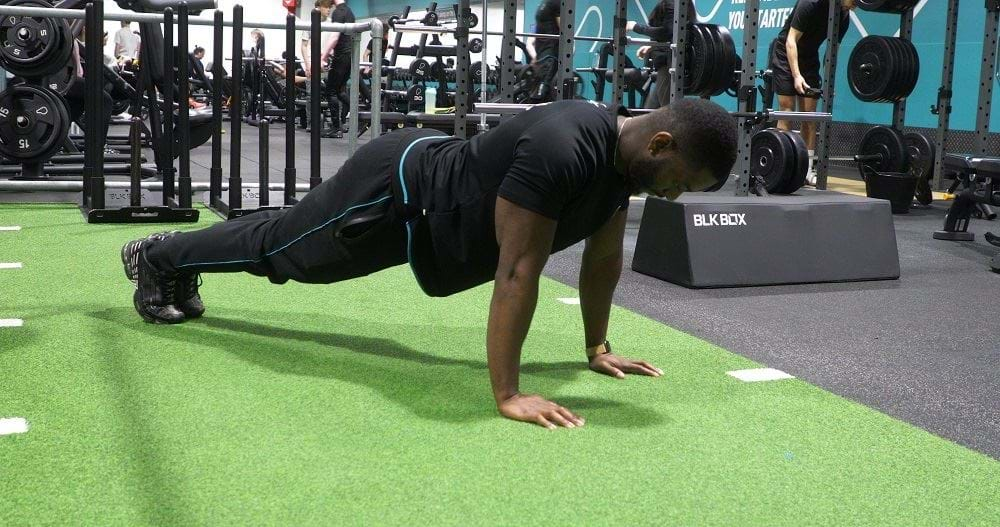Push Ups
What Is A Push Up?

Push ups (also known as press ups) are a challenging bodyweight exercise that can be done anytime, anywhere. Push ups are a compound exercise, which means they work multiple muscle groups and joints at the same time. While primarily a chest exercise, the shoulders (deltoids), arms (triceps brachii), core (rectus abdominis and obliques) and legs (quadriceps) are also worked.
Push ups are a versatile exercise and can be modified to suit different fitness levels. If you're a beginner you can perform incline push ups or knee push ups, otherwise you can increase the challenge with variations like tricep push ups, diamond push ups, wide grip push ups, decline press ups or medicine ball push ups, each of which can target different muscle groups.
As with every exercise, quality is more important than quantity so check out the tips below on how to get the most from each and every rep.
Check out our other push up exercises: wide grip push ups, decline push ups, medicine ball push ups, diamond push ups, spiderman push ups
Commonly Asked Questions On Push Ups
Press ups primarily target the muscles of the upper body, but, being a compound exercise, they will naturally work a range of other areas at the same time. Key muscles worked include:
● Chest (pectoral muscles) - contract as you push your body up from the floor
● Shoulders (deltoid muscles) - help with the lifting motion of the press up
● Upper arms (triceps brachii) - play a crucial role in extending your elbows and straightening your arms
● Core Muscles - work to keep your body stable and aligned
● Scapular stabilisers - keep your shoulders stabilised throughout the press up
● Lower back and glutes - key in keeping your body in a straight line from head to heels
● Biceps and forearms - assist in controlling the movement
One of the key benefits of push ups is the improvements to upper body and core strength you can enjoy if you include them in your exercise routines. They can also help burn some additional calories, increase muscle endurance and help to tone your chest and shoulders.
Alongside these health benefits, they’re also incredibly convenient as they don’t necessarily require any equipment, so can be incorporated into workouts both in and out of the gym. Press ups are extremely versatile too - by shifting hand positions, supporting your body with your knees or changing the degree of incline or decline, you can easily find a challenge level to suit your abilities.
Exactly how many press ups you ‘should’ do each day depends on your fitness level and goals. It's generally recommended to start with a number that challenges you but is manageable with good form. You can begin with 10-20 push ups and gradually increase the number as you become stronger. Some people aim for 50, 100, or more push ups a day, but it's important to listen to your body and avoid overtraining.
Push ups alone may not burn a significant number of calories, but they can contribute to your overall calorie expenditure if you include them as part of a well-rounded workout routine. To lose fat, it's important to combine regular exercise with a balanced diet and potentially incorporate other forms of cardiovascular exercise to create a calorie deficit.
The number of push ups you should be able to do varies from person to person. Your fitness level, age, and training experience all play a role. Overall, it's more important to focus on your progress and the quality of your form rather than a specific number. If you can’t do many push ups initially, don’t be discouraged, you can gradually increase the number of reps you do over time as you strengthen all the necessary muscles.
If you're having difficulty doing push ups, it could be due to a lack of upper body strength, poor form, or specific physical limitations. You can work on improving your push up performance by starting with easier variations (such as knee push ups and gradually progressing to standard push ups. Strengthening the muscles involved in push ups through other exercises can also help.
Some people may have challenges limiting them from doing press ups such as their anatomy or joint issues – if you experience any pain please make sure to consult a doctor or qualified practitioner like a physio.
Push Up Tips
● Lower your body until your chest is close to the ground without touching it - this ensures a full range of motion.
● Maintain full body control as you lower your body, maintaining tension in your chest and triceps.
● Keep your core engaged and your glutes tight to maintain a stable body position.
● Inhale as you lower your body to the ground and exhale as you push your body back to starting position.
How To Do A Push Up
Start in a high plank position, with your hands placed on the floor, slightly wider than shoulder-width apart.
Your body should form a straight line from your head to your heels, with your feet together.
Slowly lower your chest towards the floor by bending your elbows while keeping them close to your sides. Make sure your abs are tight and your spine is in a neutral position.
Your chest should come close to the floor and your elbows should be at around a 90-degree angle.
Slowly push back up to the start position by straightening your arms.
Repeat for the desired number of reps.
If you’re not sure if any of the above exercises are suitable for you, please consult your doctor before you start it. Need guidance on how to perform the exercise? Ask a personal trainer at your gym.